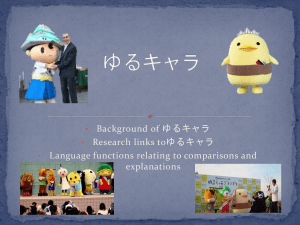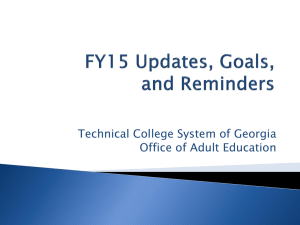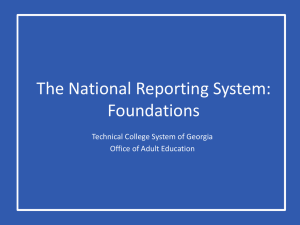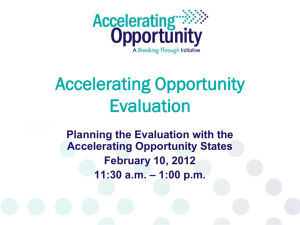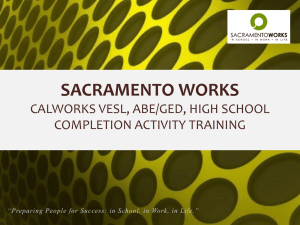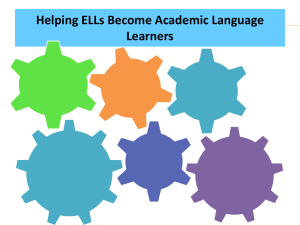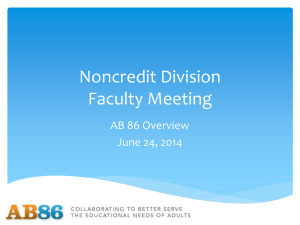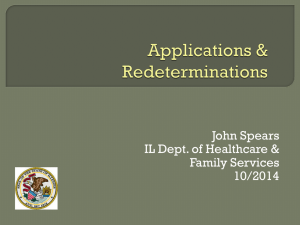Teaching adults with learning challenges: ABE Teachers
advertisement
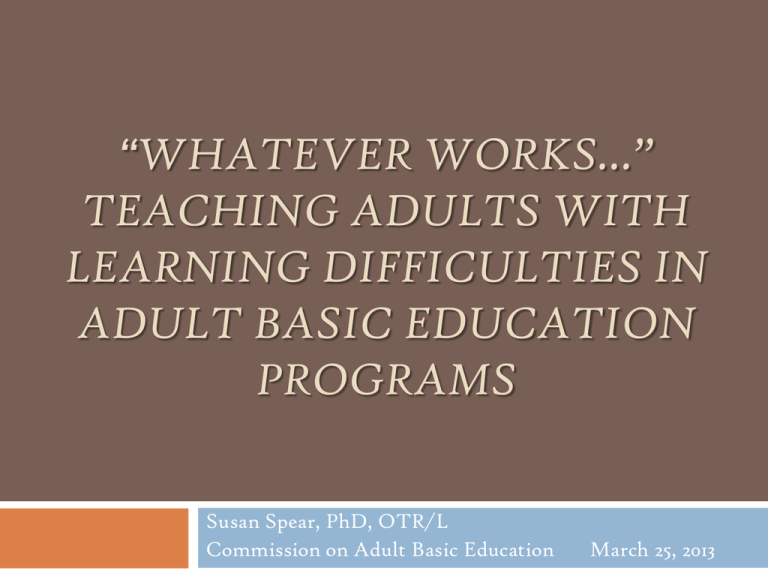
“WHATEVER WORKS…” TEACHING ADULTS WITH LEARNING DIFFICULTIES IN ADULT BASIC EDUCATION PROGRAMS Susan Spear, PhD, OTR/L Commission on Adult Basic Education March 25, 2013 Dissertation: 2011 A qualitative research study exploring the perceptions of Adult Basic Education teachers regarding their teaching practice with adult learners who have learning difficulties What the literature says: Terminology Learning Preferences ALL POPULATIONS Learning Difficulties DEPENDS ON CIRCUMSTANCES OR SPECIFIC TASKS Learning Disabilities LEGAL TERM (from “Learning to Achieve,” National Institute for Literacy, 2009) Background and Context for Study: Who is the researcher? Occupational therapist for 29 years in mental health settings Master’s degree in Adult Education--directed study project completed at Portland (Maine)Adult Education program Teacher in Portland Adult Education’s “New Directions” program Worked with Maine Office of Adult Education on research to determine prevalence of learning disabilities in the state Trainer for NIFL’s Learning to Achieve training for adult basic education (ABE) teachers Background and Context for Study: Exploring new ground… Occupational Therapy Adult Education Background and Context for Study: Why this topic? Estimates of up to 80% of learners in ABE programs with learning disabilities/difficulties (Mellard & Patterson, 2007; White & Polson, 1999) Most ABE teachers are women in part-time positions with low salary and no benefits, with limited resources for teaching and professional development; often an “accidental” job choice (Smith & Hofer, 2003) Educational support services--including occupational therapy--are available to eligible learners in the K-12 system, but typically not to struggling adult learners in ABE programs (Polson & White, 2000) ABE field is calling for more teacher research as a way to determine effective practice (Smith & Hofer, 2003; Bingman & Smith, 2007) Purpose of research study Explore the current teaching practice of ABE teachers with students who have learning difficulties, to better understand the alignment of teachers’ skills and students’ needs Add teachers’ voices and experiences to the discourse about effective teaching and learning for adults with learning difficulties in ABE programs The Research Question “How do adult basic education teachers describe their teaching practice with adult students who have learning difficulties?” Professional development needs? Additional resources? Research Design: Methodology Qualitative research approach Interpretivist/constructivist research paradigm Data collection methods: Individual, interview face-to-face, semi-structured Demographic data sheet Research Design: Participants Purposeful, homogeneous sample of ten ABE teachers: All participants had attended Learning to Achieve training All participants are white and taught in southern Maine Age range was 28 to 62, with a median age of 47.5 Nine female, one male Four participants had ten or more years of experience teaching in ABE programs, while four had 3 years experience or less Half the sample held adult education certification in Maine Seven participants worked full-time in their ABE programs The majority taught English, with only 3 participants teaching math full-time Two participants had been educated as K-12 special education teachers. Trustworthiness and Limitations Trustworthiness Researcher reflected on and clarified her assumptions Choice of semi-structured interview as the data collection tool Pilot study conducted in advance to test interview method and questions Researcher transcribed all ten interviews All ten participants provided member checking of interview transcripts Peer review by three colleagues tested researcher’s initial codes on the same transcript Limitations The subjectivity and bias related to the researcher’s role and position within the ABE field in Maine Only Learning to Achieve attendees who had attended trainings facilitated by this researcher were solicited to participate in the study Small sample size and the demographic characteristics of the participants in this study Data Analysis/Interpretation Multiple readings of transcripts using a “template approach” (Crabtree & Miller, 1992, p. 18) to extract themes from the data Earliest themes used to construct primary codes that served as categorizing containers for data Compiled Data Summary Tables (Bloomberg & Volpe, 2008) that aggregated all of the participants’ responses to each interview question; refined codes Created poster boards to categorize text segments by theme Sought peer and committee input on codes/themes Created Data Summary Charts (Bloomberg & Volpe, 2008) to track the frequency of participants’ responses to the four major categories of the conceptual framework and their subthemes Three analytic categories were processed through an Interpretation Outline Tool devised by the researcher as a method of brainstorming and thinking critically about the findings to ensure thorough interpretation of the data Finding 1 All ten participants described their teaching practice with adults who have learning difficulties with responses that reflected four themes: Identifying their students’ learning difficulties Their perceived role and identity as an ABE teacher Specific teaching methods they used with students in the ABE classroom ABE system issues that affected their practice Finding 1: Participants’ Voices Identifying their students’ learning difficulties: Markers or patterns: …when we start a new lesson and we’re learning new material, one student learns it very quickly and the other student takes a little bit longer (Kate) …if someone has an alphabetics issue, you can see it in their spelling (Jane) Socioeconomic status: I think you can have a low-level learner, and they don’t necessarily have a difficulty. But they’ve not had the right supports in place, they’ve not been engaged in their school, their parent hasn’t been engaged in school, so they hate reading. They never read a book, they may be reading at the 5th grade level when I get them…it’s not a disability, they had the ability, they just didn’t have the right things; it’s a low socioeconomic issue—not going to school, moving around a lot… (Jane) Finding 1: Participants’ Voices Identifying their students’ learning difficulties: Learning disability diagnosis? …in adult ed nobody comes to me with an identified difficulty or disability, and technically that’s a complaint I have. (Carol) …it becomes evident early on when they’re doing their math that there is a learning issue. And you know it’s a crapshoot as far as figuring out what it is.(Jim) ~~~~~~~~~~~~~~~~~~~~~~~~~~~~~~~~~~~~ In terms of diagnosis…I try to take them where they’re at, and then give them whatever cushion they need to get to the point where some of the others are. (Deb) I don’t feel in many cases that I need that identification because even if you give me a piece of paper and say, ‘this, this, and this,’ I don’t always think that it’s going to help me a lot, because I feel like I have to find what’s going to work with the person, you know? (Theresa) Finding 1: Participants’ Voices Their perceived role and identity as an ABE teacher: Providing job training Teaching foundational skills I’m teaching them academics.(Kate) Joining with students around their life goals So what is my job? How am I to train them? What am I training them for? (Angela) I want to know what their aspirations are and I plan my instruction around that. (Carol) Student outcome Because there have been students where they’ve worked really hard, they’re kind of borderline… I’m going to give them the 70 they need to get on and do something else. They may regret that I did that, when they get to something else. (Deb) Finding 1: Participants’ Voices Their perceived role and identity as an ABE teacher: Relationship: Sometimes he’ll just say to me, “I can’t get it;” I mean, we have that relationship, you know?(Theresa) I love, I love what I do, and I love teaching writing and I love my students, and I get all hyped up. So they tell me that because I’m all hyped up, they get hyped up. (Pam) Well, you know, adult education teachers are very warm, compassionate; we love our students! (Anne) Finding 1: Participants’ Voices Specific teaching methods they used with students in the ABE classroom: We do one on one, graphic organizers, flash cards; we’ve been starting a math journal where they take their notes and I ask them questions about what we did during the day and they go home and write about it. (Ashley) We follow the ‘I do, we do, you do’ (technique) so I’m always modeling things first just to make sure, and then we do it all together. And that’s a process that creates a lot of comfort. (Anne) And so when I said to do a rough draft of his essay, he just went off and did this massive web design. And I said, OK, must remember—do more web things for him because that’s what he’s going to…that obviously works with his mind and the way he works. (Carol) Finding 1: Participants’ Voices ABE system issues that affected their practice There should be math teachers…it’s too bad we can’t hire a really good one, share them, pay them benefits, and have them go from adult ed to adult ed. Because that’s what they [teachers]want, they want full-time, they want benefits, and if we’re going to get the best people, why aren’t we looking at ways to get them… (Jane) … if we had the time to actually use their assessments as we should, we would have a route mapped out for each student. If we have a class of eight students we’d say, “Where does this overlap? Where do all my students need work? Or do I divide them into two groups—they need to work on this”… again that comes down to funding; do people have time to link the assessment to the instruction? (Anne) Finding 2 The overwhelming majority (9 out of 10) of participants discussed the importance of professional development opportunities to support ABE teachers’ ability to work effectively with adults with learning difficulties in ABE programs. Finding 2: Participants’ Voices FORMAL: …maybe for ourselves, the training to know how to deal with specific learning disabilities. Because I’m sure in adults they’re different; they have in some way manifested themselves differently than they do in kids, and also the other point is that at that stage in life, you may not ever be able to cure…you know, all you can do is teach them a few tricks, and if they haven’t learned them, give them some new ones. I would like some tricks, you know? (Carol) Seriously, I would do a differentiation course; I think everybody probably needs to do one every two or three years. (Carol) I really feel there’s a clear difference between the way I operated before STAR and after STAR—much more focused; much more productive…it’s just a great tool for a great process for moving them along. And so I am; some people instinctively can be just as good with their students, but I think we’ve got a very evidence-based practice. People shouldn’t have to be taking a shot in the dark and reinventing the wheel every time they step into an adult ed classroom; it’s not necessary, it’s not fair, and it’s not being efficient. (Anne) Finding 2: Participants’ Voices INFORMAL I definitely could use some professional development; or like I said, some opportunity to share students’ difficulties with other teachers and get feedback on what strategies they’ve come up with. I think having more than one brain is better than just one. (Angela) …it hasn’t been like this one class or that; it’s really been my awareness of what I think people need, me looking for it on my own because I have nobody here to talk to. (Jane) I certainly think for the programs I’m in, we have very few meetings where we can confer with each other and share ideas. Unless we’re involved in one of those workshops that somebody else puts on…because of funding, there really aren’t opportunities. We share occasionally; I’ve picked up really great suggestions from people and likewise offered some that have made a lot of difference. And there are too few opportunities to use the resources we already have among the teachers. I think it’s important to have opportunities to share what people already know. (Anne) Finding 3 All ten participants cited one or more teaching practices or additional resources that would better support teaching and learning in ABE programs Finding 3: Participants’ Voices First of all, being able to identify [students with learning difficulties], and of course we’re not even equipped to do that… if we had a suspicion that a student had something, the first thing you have to do is be able to identify it. So there’s assessment, some kind of a test. You have to have personnel that are educated in it to deliver these kinds of assessments and stuff. And then digest the information and identify an issue. (Jim) … coming up with a better assessment process would be helpful for them to see what their gaps are specifically…and having strategies that are particular to those learning difficulties… (Angela) Boy, if we had all the tools that a regular school program did, we’d be doing OK…those would definitely include the IEPs, a special ed teacher as a resource possibly, and an ed tech for students like the young man who had ADHD. (Carol) I think every teacher should have some sort of special education background or psychology degree…and having some sort of resource to test students for specific learning needs that they have would really help. (Ashley) Interpretation: “PEO” model of OT practice: (Law, Cooper, Strong, Stewart, Rigby& Letts, 1996) Person Environment Occupation Conclusions Teaching adults with learning difficulties in ABE programs is a complex practice that defies a singular descriptive factor and causes varying levels of concern and uncertainty in the teachers who are doing it. To practice effectively in ABE programs, teachers utilize both highly-developed interpersonal skills in order to develop relationships, and knowledge/intuition of teaching methods that work for students with learning difficulties. Regardless of their years of experience, ABE teachers often feel underprepared to teach students with learning difficulties, especially with large numbers of students with different needs in the same classroom. Conclusions The teachers’ call for additional resources (e.g. special education and diagnostic assessment services) was in response to their perception that they lacked the necessary expertise to meet their students’ needs. Engaging teachers in ABE program evaluation and development would uniquely inform that process with their critical input about the effectiveness of service provision. The like-minded practice models of ABE and Occupational Therapy suggest a role for occupational therapists to support learners in their student role in ABE programs. Recommendations: ABE Field Engage ABE teachers as primary stakeholders in the profession Provide and fund creative, progressive means of professional development Promote and fund research specific to the adult ABE learner population Investigate the application of educational support services and other models used in K-12 to address ABE learners’ needs, e.g. Occupational Therapy, Universal Design for Learning (UDL) and Response to Intervention (RtI) Recommendations: ABE Teachers Explore mentorship models that intentionally bring the expertise of experienced teachers to bear on the nascent practice of the newest ABE teachers Create and facilitate Communities of Practice (Wegner, 1998) for teachers at all levels of experience, to problem-solve, share strategies, and develop expertise Find ways to actively engage in the planning and design of robust professional development opportunities Recommendations: Further Research More qualitative studies that highlight the voices of ABE teachers and address the limitations of this study--larger samples including more teachers who are men, who work part-time in ABE, who work in other areas of the U.S., and who have had no prior training in learning difficulties--to expand the conversation about adult learning difficulties with the first-hand experience of ABE teachers Action research projects that bring additional educational resources, e.g. special educators, occupational therapists, and psychologists, directly into ABE programs to evaluate the utility and effectiveness of those resources on teaching and learning in ABE programs References Bingman, M.B. & Smith, C. (2007). Professional development and evidence-based practice in adult education. In A. Belzer (Ed.), Toward defining and improving quality in adult basic education (pp. 69-84). Mahweh, NJ: Lawrence Erlbaum Associates. Bloomberg, L. & Volpe, M. (2008). Completing your qualitative dissertation: A roadmap from beginning to end. Thousand Oaks, CA: Sage. Crabtree, B. & Miller, W. (1992). Doing qualitative research. Newbury Park, CA: Sage. Law, M., Cooper, B., Strong, S., Stewart, D., Rigby, P., & Letts, L. (1996). The person-environment-occupation model: A transactive approach to occupational performance. Canadian Journal of Occupational Therapy, 63, 186192. Mellard, D. & Patterson, M. (2007). Program characteristics that predict improved learner outcomes. Adult Basic Education and Literacy Journal , 1, (2), 83-92. References National Institute for Literacy (2009, June). Learning to achieve: A review of the research literature on serving adults with learning disabilities, Washington, DC. Accessed at http://www.nifl.gov/publications/pdf/L2ALiteratureReview09.pdf Polson, C. & White, W. (2000). Providing services to adults with disabilities: Barriers to accommodations. Adult Basic Education, 10, (2), 90-99. Smith, C., & Hofer, J. (2003). The characteristics and concerns of adult basic education teachers (NCSALL Report No. 27). Boston: National Center for the Study of Adult Learning and Literacy. Wenger, E. (1998). Communities of practice. Cambridge, UK: Cambridge University Press White, W. & Polson, C. (1999). Adults with disabilities in adult basic education centers. Adult Basic Education, 9, (1), 36-47. Full dissertation reference list available on request: sspear@usm.maine.edu
